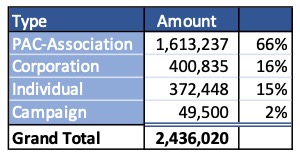CommentsGUEST COMMENTARY - Sometimes it’s clear whom we’re “supposed” to vote for. But on what basis do we decide?
I’d rather the basis were factual, and beyond some loyalty-prerogative exacted by friends and allies. But evidence is manipulable too, and unevenly present between incumbent and non-incumbent. Even nominal records need scrutiny for coincidence and inconsistent association, else the political process degenerates to coronation.
One problem with political incumbency can be described by way of a riff on Einstein’s definition of insanity: ‘re-electing the same candidate and expecting a different legislative work product.’
There’s a lot to explore in the aphorism: re-election and candidacy; legislative work, and work product; and knowing and evaluating all.
As a voter, it’s on us to evaluate legislative work product. But it turns out to be hard to follow one legislator’s work product, because the legislature reports voting record by bill, not lawmaker. There doesn’t seem to be a public database for tracking the history of a legislator’s votes (though a free account here might provide close).
So a common work-around for tracking legislator-positions is to track the source of the candidate or legislator’s donations, which are reportable by law and therefore quasi-readily available. The hope is the record might elucidate a legislator’s positions by reflecting a shared sympathy for issues and institutions.
But parsing money is not the same as correlating it with voting record, necessary for inferring cause and effect. Yet when your representative challenges you to show them how their voting record correlates with the money they accept, that turns out to be something of a fool’s errand: it’s next to impossible to do because of the opacity of the public record.
And this is an advantage of incumbency – keeping it so.
For example, recall the drama of AB1400, aka “CalCare”, the latest bill in California’s long history of supplications to maximize healthcare for all. That bill was pulled from the floor at the eleventh hour avoiding any formal recording of vote, because of the author’s (Ash Kalra, from San Jose’s AD27) ‘insider’s assertion’ that the bill ‘did not have the votes necessary to pass.’ And in a classic exhibit of ‘blame the victim,’ we citizens were exhorted to “elect better legislators.”
Here’s the dilemma: how are we to elect better legislators, when we cannot discern the work record of those we have? When their true positions are effectively shielded from public view by these sorts of institutional sleights-of-hand, that protect incumbents from accountability?
The incumbent’s prerogative enables legislatively folding a bill’s hand, without showing its telling contents. But worse, what if by rumor alone, an incumbent with opaque record is supported on the strength of that reputation, to the detriment of a candidate whose position is crystalline? Adding injury to insult, the charge to “elect better legislators” is not just quixotic, but crippled.
Imperfect though it may be, therefore, the tedious task of scrutinizing donations for policy-patterns remains the best poor-man’s tool available.
Tables 1-8 [below to start, and in the appendix at the end. Press the hyperlinked main, regular text to open tables in a separate window. Press the hyperlinked italicized text beneath each included table to open the tables as a pdf] present several perspectives on campaign donations to one of AB1400’s co-authors, northeast-East LA incumbent State assemblymember Wendy Carrillo (AD52).
Campaign account holdings are under the candidate’s control, yet capped in donation-size by law. In contrast, accounts not under the candidate’s control, described as “Independent Expenditure Committee” (IEC)’s, may reflect donations that are more dramatic, yet fail to reveal the breadth of interaction and influence of a directly-controlled donation. Moreover, like the performative bill for which no final vote is recorded, accountability is dodged regarding IECs, but a candidate’s monies – and contributors – are their own.
Of particular interest are patterns among donations classified by money “source-type”. And the appearance of individuals with a history of notorious behavior. These records are no proof of malfeasance. And the power of incumbency seems to provide opportunity for blocking information flow that might show correlation or cause-and-effect. But since the voter’s principle of caveat emptor remains, we are relegated to this imperfect, eyebrow-raising, oblique exercise.
Table 1 shows the relative distribution of Assemblymember Carrillo’s donations according to broad source-type. Well over 80% of her monies derive from political action committees (PACs), trade or industry associations and corporations. Her support is quintessentially big money-establishment-oriented.

Table 1: Distribution of candidate Assemblymember Carrillo’s donations averaged across three election cycles: 2017 (pre-election), 2019 and 2021. Individuals (including candidate-campaigns) comprise a small part of her donations; large corporate and union entities comprise the bulk of it.
(Sara Roos is a biostatistician from northern New England living in West LA. Raising children from private to charter to public schools provides a front-row seat to the microcosm of electoral politics that is education politics. She started blogging this experience at redqueeninla.com, eventually co-publishing the LA Education Examiner. Sara is an elected delegate to the LA County and state Democratic Party Committees since 2020. Her monthly constituent newsletter and essays can be found at redqueeninla.com.)











